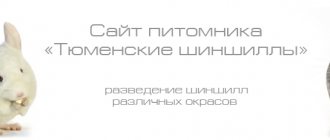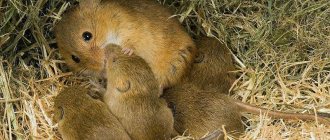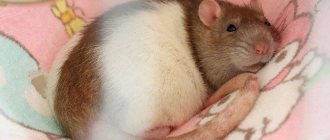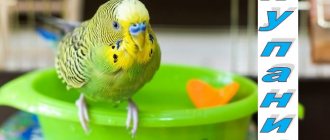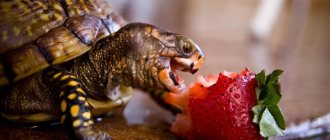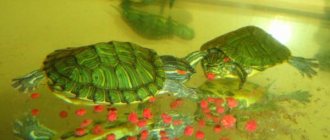The intricacies of breeding cockatiels are not known to everyone, and therefore novice breeders often experience failure. To deal with this issue, it is necessary to prepare well and study the behavioral characteristics of parrots and their needs.
We will learn how to properly prepare for mating birds, not make a mistake in choosing a male and female, and correctly organize the breeding of cockatiels.
general description
A medium-sized parrot from the Cockatoo family weighs 100 g. The body size is about 30 cm, the tail length reaches 15 cm, the wingspan is 40 cm. The beak is small, but quite powerful. A distinctive feature of cockatiels is a high crest on the head.
Natural coloring is not very bright; males look somewhat more colorful than females. Chicks at a young age have the same faded coloring as females. Only when they reach the age of puberty do males acquire their characteristic plumage. Usually changes begin to occur from 6 months of age.
Corellas reproduce well in captivity; artificially bred parrots have a wide variety of plumage color options. The most common mutation is lutino. Individuals of this species are yellow in color. They have red eyes and orange cheeks.
Cockatiels live only in Australia. These birds are monogamous. Their breeding season coincides with the rainy season and lasts from October to December. Parrots make their nest in the hollow of a dead tree at a height of 2 m above the ground. The female lays 4 to 7 eggs, one egg per day.
Both parents are equally involved in incubating eggs and feeding chicks. The chicks hatch after 17-23 days and are completely helpless. After 5 weeks, the chicks leave the nest. They reach puberty at 6-11 months.
In the wild, cockatiels live 12-15 years. If kept at home, a parrot can reach the age of 25 years with proper care.
Selecting a pair of cockatiels for mating
Good offspring of cockatiels can only be obtained if both parents are completely healthy, sufficiently mature, and are not close relatives to each other.
Appearance and health
First of all, the selected pair of parrots must have excellent physical and mental health. When purchasing, it is important to pay attention to the external condition of the birds - they should be cheerful, react with curiosity to strangers and to the entire environment in general.
You will probably be interested in reading about how to determine the age and sex of a cockatiel parrot.
Even if there are no visible diseases or injuries (apathy, weakness, inexplicable aggression), the future owner should still be on the safe side - after purchasing, take the new pets to the nearest veterinary laboratory for special avian tests confirming the absence of any inflammatory processes in the body of the cockatiel.
Age
Another important factor is the age of the cockatiel. Despite the fact that these birds are physically capable of breeding from the age of 6 months, it is extremely undesirable for them to breed offspring before the age of one and a half years.
Did you know? Of all the countless species of birds, only parrots can absorb food while holding it in their paws.
Otherwise, young males may simply be infertile, and young females may have problems laying eggs. Unlike the chicks of adult parrots, the offspring of immature young are born weakened and very rarely survive due to the lack of maternal instinct and basic care skills in inexperienced parents.
Not related
Breeding closely related cockatiels (inbreeding) will also be a big mistake. The consequences of such an experiment will probably be the most unexpected and will have an extremely negative impact on future chicks:
- various deformations of the beak, claws, paws, wings;
- painful orthopedic problems;
- impaired functioning of internal organs;
- infertility;
- weak immune system and high susceptibility to diseases.
Check out the common colors of cockatiels.
Features of behavior
When planning to breed cockatiels at home, pay attention to the behavioral characteristics of these parrots. The emotions they experience are clearly demonstrated by the parts of the bird’s body:
- Excitement, alertness - the crest stands upright, eyes wide open.
- Aggression, preparation for an attack - the crest is slightly tilted and pressed to the head, the pupils are dilated, the feathers are ruffled, the tail is loose. The bird clicks its beak and flaps its wings.
- Playfulness - the crest is held straight, lightly touching the back, eyes narrowed.
Parrots have a harsh and unpleasant voice. The more excited the bird is, the higher the voice.
If a cockatiel hisses, it is a sign that it is preparing to attack. A parrot reacts this way if it believes that an attempt is being made to take over its home. You should not stick your fingers between the bars; cockatiel bites are very painful.
Corella is sensitive to affection. She enjoys scratching her head and ruffling the feathers on the back of her head.
Cockatiels are shy. When experiencing stress, untamed parrots can become aggressive when given a new owner. It is better to buy birds from a nursery or from trusted breeders. It is not recommended to adopt an adult, unsocialized bird: it will not be able to get used to its owner and will cause him a lot of trouble.
Appearance
Medium sized parrot. About thirty centimeters tall. This includes the tail. An adult bird weighs 100-150 grams.
A distinctive feature of the species is the crest on the head. The color can be either pale yellow or bright yellow.
The color of the cockatiel is unusual. And the male differs from the female in brightness. Its body color is olive-gray. The head and crest are yellow, and there is a “blush” on the cheeks. The male's cheeks are colored red. The flight and tail feathers are velvet. Their color is black, with a bluish-gray tint. The cockatiel's beak is similar to that of a cockatoo. Only much shorter.
The main color of females is dirty gray. There are spots on the cheeks, but they are pale brown. The head and crest are pale gray. In addition, “ladies” are smaller in size than males.
Breeding
Breeding cockatiels is not difficult; As soon as parrots are 6 months old, they are already able to reproduce. But it is better not to subject a fragile organism to such a test and give the chicks the opportunity to grow up to one and a half years old.
In nature, parrots breed in the fall. At home, you can encourage cockatiels to mate by artificially creating suitable conditions for them; for this you need to:
- Find compatible partners.
- Ensure correct lighting conditions.
- Offer complete food.
- Place a nest in the cage.
It is advisable to purchase a spacious tall cage of rectangular or square shape. To breed a cockatiel at home, you need to provide a pair of parrots with a large cage, at least 70x70x150 cm.
Walk
Like other types of parrots, regular walks are absolutely necessary for the cockatiel. When letting a bird fly around the room, you need to follow safety precautions. All other pets must be removed from the premises immediately. Windows and doors should be closed to prevent birds from flying out or a cat or dog from entering the room.
It is advisable to cover the mirrors with some kind of fabric so that the bird does not accidentally dive on them. Plants can also be removed from the room so that the parrot does not peck at them. The duration of the walk should be approximately 1-3 hours. While the parrot is walking, you can clean the cage.
When the parrot flies around the room, you need to carefully monitor it.
Compatibility issues
When a pair of opposite-sex cockatiels live together from a young age, and they have no alternative to meeting other partners, their friendships can gradually turn into marital ones. The resulting mutual interest will clearly manifest itself. The birds will sit side by side on a perch and gently touch each other’s feathers with their beaks. The male's readiness to mate is demonstrated by the increased intensity of his chants.
If your pet is raised alone and aggression occurs when a foreign parrot is introduced between the cockatiels, this may be due to increased testosterone levels in the male. A short separation usually solves this problem. If mutual hostility does not go away, you will have to take care of acquiring other marriage partners.
Where to buy a pet?
You can purchase a representative of the species at a pet store. A bird costs about 5000-6000 rubles. Depending on the region in which the store is located.
When purchasing a bird, you must be given a certificate of its health. If they don’t give it, demand it. Before entering the sales area, the birds are examined by an ornithologist.
It is better to purchase a parrot from a breeder. There are many nurseries in Russia where you can choose a healthy and beautiful bird. In addition, it is recommended to buy a chick. This is feasible in a nursery, but this cannot be said about pet stores. Adult birds are sold there. And they are not always young.
The only point: a chick from a nursery is expensive. Its price can be twice as high as in a pet store.
What to feed
When breeding cockatiels at home, parrots are fed well-balanced food. A grain mixture for medium-sized parrots is suitable for this. Additionally, add to the diet:
- grated carrots;
- pieces of cabbage;
- slices of apple, pear;
- plantain seeds;
- dandelion leaves;
- a few drops of vegetable oil;
- sprouted grains;
- honey (2 g 1 time per week);
- boiled egg (2 - 3 times a week, a little).
Honey and butter can be given on a small piece of bread. Birds love to chew on fresh tree branches. The cage must contain special mineral supplements in the form of sand and pebbles.
After the birds settle into the nest for brooding, soft egg food should be excluded from their diet. Its presence stimulates the female to lay more eggs.
When the chicks hatch, the mashed egg becomes their main food and is returned to the feeder. Grown chicks, feeding on their own, switch to the regular diet of parrots.
Parents feed their babies by regurgitating food directly into their beaks. Chicks can be taken from their parents for artificial feeding when their eyes open. This usually happens on days 10–12. The “foster babies” are fed liquid warm porridge made from infant formula. You can also feed “natural animals” in order to accustom them to human hands.
Communication and training
How to quickly tame a cockatiel? The main rule here is regularity and gradualness. You can’t try to put a parrot on your hand right away. He will simply get scared and show aggression. You must gradually, every day, bring your hand closer to the bird. He must get used to it and not feel danger from the owner. In order for a parrot to jump onto your hand, it must contain his favorite food. Once the parrot is completely tamed, you can begin to teach it to speak.
Regularity and gradualness are also important in teaching speech. You need to start with the simplest words, which contain the vowels o and a. After the pet has mastered them, you need to move on to more complex words, and then to phrases. During lessons there should be a friendly atmosphere. The use of punishment and violence against a pet is unacceptable. The optimal duration of classes is 15-25 minutes, but they should take place every day. If these conditions are met, the cockatiel will learn to speak quite well.
Requirements for daylight hours
Long daylight hours stimulate parrots to reproduce; for cockatiels it should be at least 16 hours. Before this, the birds are kept on a shortened day for a month, its duration is 8 - 10 hours. During this period, parrots must undergo molting, their gonads are activated.
The required length of daylight can be ensured with the help of additional sources of artificial lighting and dense material thrown over the cage. The parrot needs to add more “day” gradually, 10 minutes every day. Too sudden a change in conditions can negatively affect his sexual function.
Comfortable indoor conditions for the breeding pair are maintained with a constant air temperature of 18–20 °C and a humidity of 50–60%.
Feeding the chicks
For three to four days, the female feeds the chicks with a yellowish-white liquid - chamois milk. After this time, the cockatiel begins to feed them with the male's semi-digested food.
If the birds, due to overwork and lack of parental instinct, do not start feeding the chicks, they will need help.
Feed your chicks baby formula every two hours. It should be liquid and heated to a temperature of thirty-five degrees. For convenience, use a syringe without a needle.
After a week, start feeding the chicks every three hours. When the baby is two weeks old, add well-prepared liquid millet porridge to baby food. Increase the amount of food you eat so you don't have to feed your children at night. When the chicks are a month old, start feeding them a tablespoon of grain mixture five to six times a day until they begin to eat on their own.
If you have raised cockatoos before, please share your experience with us. Perhaps you have something to add.
If you liked this article, please do.
Arrangement of the nest
A nest placed in a cage serves as a signal to encourage parrots to mate. This process usually takes about a week, but there may be exceptions. A special box is used as a nesting box; it can be bought in a store.
By the behavior of the parents, you can accurately determine when eggs will appear in the nest. The birds alternately perform the duties of a hen: during the day the male takes care of the eggs, at night the female replaces him at post. After 21 days from the moment of laying, the chicks will begin to appear.
What does a healthy bird look like?
Breeding cockatiels is a responsible process. It must be approached very carefully. As stated above, both parents must be healthy.
How to distinguish a healthy bird from a sick one? If the parrots are cheerful, curious, willing to make contact and chirp loudly, they are healthy. At least there are no external signs of illness.
After purchasing, it is recommended to visit an ornithologist. He will examine the birds and take the necessary tests from them. After all the procedures and 100% confidence in the health of the parrots, you can think about breeding.
Mating season
Do you want to get cockatiel offspring? You can get a pair of cockatiels for breeding. Of course, if you are ready to provide them with everything they need to start the process.
The mating season for cockatiels does not last long. Watching him is a pleasure. The male behaves like a true gentleman. Hovering next to her friend, fluffing her wings. Sings her serenades, caresses her tenderly. As soon as the female is in the nesting house, the male does not want to let her out.
Nutrition during hatching
To successfully breed a cockatiel, the bird must be fed intensively at the time of incubation. Her diet is replenished with the following products:
- oat sprouts;
- steamed oats;
- low-fat granular cottage cheese;
- boiled chicken eggs;
- carrots, raw and boiled;
- red apples;
- citrus.
The eggs are hard boiled. Cool and rub through a fine grater. And after that they feed it to the birds.
Carrots are given in small pieces. And cottage cheese should not be in the parrots' feeder for more than three hours. It can turn sour and pets will get food poisoning.
The appearance of eggs
After the mating season, 8-10 days pass. And the first egg appears in the nest. It is small and white. After two or three days, the egg is laid again. The number of eggs in a clutch reaches 6 pieces. Very rare, but there are 7-8 eggs.
Incubation lasts 20-23 days. Cockatiels take turns incubating their babies. The closer the most crucial moment is, the more responsibilities are assigned to the female. the future father guards the house and brings food. And the female hatches the eggs.
